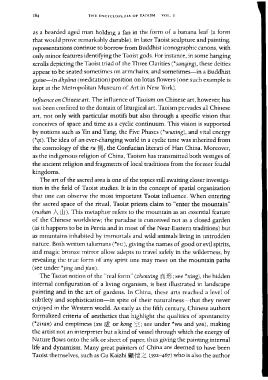Page 224 - The Encyclopedia of Taoism v1_A-L
P. 224
THE ENCYCLOPEDIA Of TAOISM VOL. I
as a bearded aged man holding a fan in the form of a banana leaf (a form
that would prove remarkably durable). In later Taoist sculpture and painting,
representations continue to borrow from Buddhist iconographic canons, with
only minor features identifying the Taoist gods. For instance, in some hanging
scrolls depicting the Taoist triad of the Three Clarities (* sanqing), these deities
appear to be seated sometimes on armchairs, and sometimes-in a Buddhist
guise-in dhyana (meditation) position on lotus flowers (one such example is
kept at the Metropolitan Museum of Art in New York).
Influence on Chinese art. The infl uence of Taoism on Chinese art, however, has
not been confined to the domain of liturgical art. Taoism pervades all Chinese
art, not only with particular motifs but also through a specific vision that
conceives of space and time as a cyclic continuum. This vision is supported
by notions such as Yin and Yang, the Five Phases (*wuxing), and vital energy
(*qi). The idea of an ever-changing world in a cyclic time was inherited from
the cosmology of the ru ffffl, the Confucian literati of Han China. Moreover,
as the indigenous religion of China, Taoism has transmitted both vestiges of
the ancient religion and fragments of local traditions from the former feudal
kingdoms.
The art of the sacred area is one of the topics still awaiting closer investiga-
tion in the field of Taoist studies. It is in the concept of spatial organization
that one can observe the most important Taoist influence. When entering
the sacred space of the ritual, Taoist priests claim to "enter the mountain"
(rushan A ill). This metaphor refers to the mountain as an essential feature
of the Chinese worldview; the paradise is conceived not as a closed garden
(as it happens to be in Persia and in most of the Near-Eastern traditions) but
as mountains inhabited by immortals and wild animals living in untrodden
nature. Both written talismans (*FU), giving the names of good or evil spirits,
and magic bronze mirror allow adepts to travel safely in the wilderness, by
revealing the true form of any spirit one may meet on the mountain paths
(see under *jing andjian).
The Taoist notion of the "real form" (zhenxing ~ %; see *xing), the hidden
internal configuration of a living organism, is best illustrated in landscape
painting and in the art of gardens. In China, these arts reached a level of
subtlety and sophistication-in spite of their naturalness-that they never
enjoyed in the Western world. As early as the fifth century, Chinese authors
formalized criteria of aesthetics that highlight the qualities of spontaneity
(*ziran) and emptiness (xu J1f!. or kong ~; see under *wu and you), making
the artist not an interpreter but a kind of vessel through which the energy of
Nature flows onto the silk or sheet of paper, thus giving the painting internal
life and dynamism. Many great painters of China are deemed to have been
Taoist themselves, such as Gu Kaizhi JiJHI't.2. (39 2-467) who is also the author

